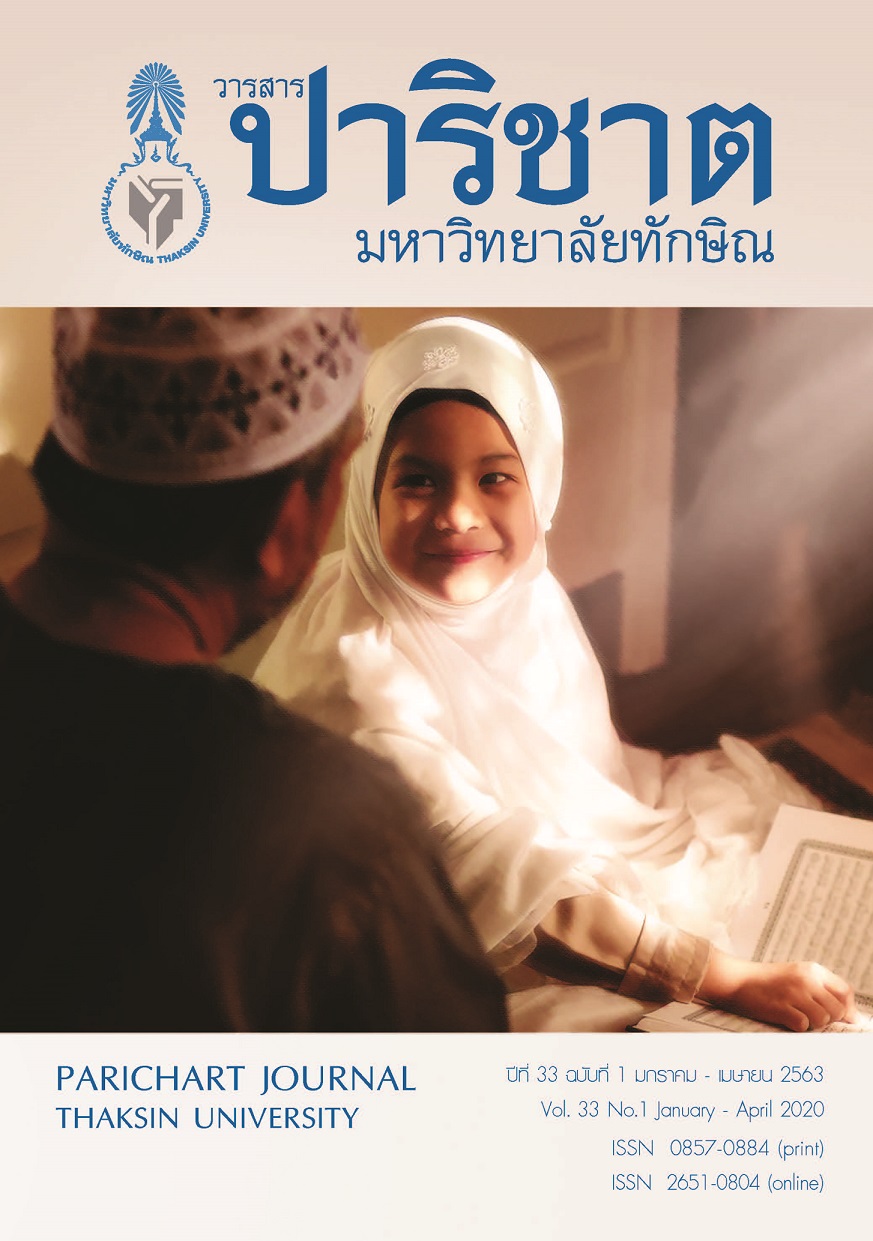มูลเหตุของการเปลี่ยนแปลงสภาพวัดไทยในสามจังหวัดชายแดนภาคใต้ ในปี พ.ศ. 2547-2560
Main Article Content
บทคัดย่อ
การวิจัยนี้มีวัตถุประสงค์เพื่อศึกษามูลเหตุการเปลี่ยนสภาพของวัดไทยในสามจังหวัดชายแดนภาคใต้ช่วงปี พ.ศ. 2547-2560 โดยใช้ระเบียบวิธีวิจัยเชิงคุณภาพ รวบรวมข้อมูลจากเอกสาร จากการสังเกตการสัมภาษณ์เชิงลึกพระสงฆ์ ประชาชนในชุมชน และนักวิชาการท้องถิ่นจำนวน 39 คน ด้วยวิธีเจาะจงไปยังกลุ่มเป้าหมายที่จะให้ข้อมูลมากที่สุด นำข้อมูลมาตรวจสอบสามเส้า วิเคราะห์ข้อมูลแบบสร้างบทสรุป และวิเคราะห์พรรณนา ผลการศึกษาพบว่าวัดไทยในสามจังหวัดชายแดนใต้ที่มีสภาพซบเซาหรือถดถอยลง ไม่เพียงสาเหตุจากสถานการณ์ความไม่สงบ ยังมีมูลเหตุอื่นประกอบด้วย ได้แก่ มูลเหตุด้านฆราวาส จากพฤติกรรมของกรรมการวัด ความขาดสามัคคีของคนในชุมชน ทัศนคติที่มีต่อวัด มูลเหตุด้านบรรพชิตจากการติดอบายมุขการจำวัดระยะสั้น การใส่ใจกิจวัตรของตนมากเกินไป และให้ความช่วยเหลือสังคมน้อย มูลเหตุจากงานก่อสร้างสาธารณูปโภค จากปัญหางานช่าง การดำเนินการ และงบประมาณ
Article Details
เอกสารอ้างอิง
Prapromkunakorn. P. (2014). The risk of Buddhism in Thailand. Retrieved on January 8, 2018, from www. youtube.com/watch?v=v2.
Pramahapreda, K.. (2013). Impact of the Buddhist way of life from the violet situation in the three southern border provinces. Master thesis, Master of Arts, Pranakornsriayutthaya:Mahachulalongkornrajavidyalaya University.
Bunyarut, S. & et. al. (2013). Impacts on religious activities for monks and novices in Yala, Pattani and Narathiwat provinces of the violent situation in the southern border. Nonthaburi: Mahachulalongkornrajavidyala University. Retrieved December 25, 2017, from https://www.mcu.ac.th/site/articlecontent_desc.php?Article_id=1664&articlegroup
Srichan, P. (2009). Way of life in the unrest situation in three southern border provinces: The case study of Buddhists in Khokpho District, Pattani Province. Master thesis, Master of Arts. Bangkok: Thammasat University.
Changsorn, W. (2010). The transformation of Thai Buddhists’ way of life after the southern violence in the three southernmost provinces of Thailand since C.E. 2004-2011: Case studies of Moo 4 Tumbol Lumphraya, Amphur Maung, Yala province. Pattani: Princess Galyani Vadhana Institute of Cultural Studies.
National Office of Buddhsim. (2015). List of all temples in Thailand. Retrieved on 27 July 2018, from https://www1.onab.go.th/index.php?option=com.
kumdee, D. (2006). Philosophy and religion : Value and role in contemporary society. Chiang Mai: Department of Philosophy and Religion. Chiang Mai: Faculty of Humanities. Chiang Mai University.
Office of Sangha Supream Council. (2005). Visiting temples, monks and novices in three southern border provinces. Retrieved on July 26, 2018, from https://mahathera. onab.go.th/index.php?url.
Office of the National Security Council. (2017). Policy on administration and development of southern border provinces in 2017-2019. Retrieved on July 27, 2018, from https://www.nsc.go.th/Download1.
Southern Border Province Administrative Centre. (2017). 20 year strategic plan of southern border province administrative centre (2017-2036). Retrieved on July 27, 2018, from https://www.sbpac.go.th/ index.php/.
Adsakul, S. (2014). Introduction to sociology (3rd Ed.). Bangkok: Chulalongkorn University.
Srisantisuk, S. (2009). Study of society and culture, concepts, methodologies and theories. Khonkaen Humanities and Social Sciences. Khonkaen: Khonkaen University.
Wankaew, S. (2006). Social and culture change in social and culture (10th Ed.). Bangkok: Chulalongkorn University.
Tanod, P. (2015). Role encouragement of priests and conflict problem in the three southern border provinces. The 5 th National Academic Conference, Phuket Rajabhat, 17-18 December 2015, at Phuket Rajabhat Conference Center, Retrieved on May 5, 2017, from https://academic-paper.pkru.ac.th/20.
Isranews Agency. (2015). Bloody robe heartbreaking in 11 Years 19 Monks Die and 25 Monks Injure for south border unrest. Retrieved on July 27, 2018, from https:// www.isranews.org/content-page/.
Promsaka Na Sakonnakorn, T., & Chandang, A. (2015). The impact of violence situation. to Thai Buddhists in the three southern border provinces. Retrieved on September 22, 2017, https://inrit-2015.com/inrit2014/Proceedings/C%201.1-1.5.pdf.
Tachapunyopikku. (2017). Why people don’t enter the temple. Retrieved on April 7, 2017, from https://www.whatami.net/lum/lum30.html.
Pawakunworakit, P. (2012). Commercial Buddhist and commerce occult into practicable. Buddhism in Thailand: Case study of temples in Nakhon Pathom Province. Bangkok: Chulalongkorn University. Retrieved on April 4, 2017, from https://www.tnrr.in.th/?page=result.
Boonnoon, C. (2008). Thai priests in future: Introduction survey of change. Bangkok: Princess Maha Chakri Sirindhorn Anthropology Centre.
Wisalo, P. (2008). “Interview words of Prapaisarl Wisalo” In Channarong Boonnoon. Thai. priests in future: Introduction survey of change. Bangkok: Princess Maha Chakri Sirindhorn Anthropology Centre.
Homkaew, P. (2017). Monks and Thai politics. Retrieved on June 6, 2017, from https://www.baanjomyut.com/library.
Rungruchee, B. (2015). “Fine arts department” aim to cooperate with universities to produce. craftsman for solve the problem of insufficient craftsman. Retrieved on June 11, 2017, from https://www. manager.co.th/qol/.


